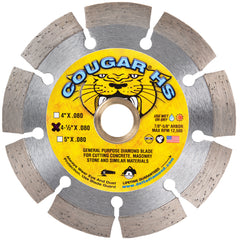
- Material Type
The first and foremost consideration when selecting a diamond blade is the material you intend to cut. Different materials have different hardness levels, and using the wrong blade can lead to inefficient cutting or even damage to the blade. Here are some common material categories and the types of blades suited for each:
a. Concrete: For cutting concrete, a diamond blade with a soft bond is ideal. Look for a segmented blade with a diamond concentration suitable for the concrete's hardness.
b. Asphalt: Asphalt blades are designed with undercut protection, and they come with a hard bond to withstand the abrasive nature of asphalt.
c. Stone: When cutting natural or engineered stone, choose a diamond blade with a continuous rim. The continuous rim design provides a clean and chip-free cut.
d. Masonry: Masonry blades are versatile and can cut through a range of materials, including bricks, blocks, and pavers. Opt for a segmented or turbo rim blade for masonry tasks.
- Blade Diameter
The blade diameter is another crucial factor to consider. It determines the depth of your cuts. Ensure that the blade you choose has a diameter that matches the depth of your cuts. Using a blade with a smaller diameter may not allow you to achieve the desired cutting depth, while a larger blade might be inefficient and cause unnecessary wear.
- Blade Type
Diamond blades come in various types, each designed for specific cutting applications. Here are some common blade types:
a. Segmented Blades: These blades have gullets (slots) that help with cooling and debris removal. They are suitable for cutting through hard materials like concrete and masonry.
b. Continuous Rim Blades: These blades are ideal for materials like tile, ceramic, and glass because they provide a clean, chip-free cut.
c. Turbo Blades: Turbo blades feature a serrated rim that combines the benefits of segmented and continuous rim blades. They are versatile and work well for a variety of materials.
d. Sintered Blades: Sintered blades are designed for cutting through extremely hard materials like granite and porcelain. They have a long lifespan but may be more expensive.
- Wet vs. Dry Cutting
Consider whether your cutting task requires wet or dry cutting. Wet cutting involves using water to cool and lubricate the blade, reducing dust and increasing the blade's lifespan. Dry cutting is suitable for quick, small jobs but may create more dust and wear out the blade faster. Choose a blade that matches your cutting method.
- Horsepower and RPM
Ensure that your saw or cutting equipment has the appropriate horsepower and RPM (revolutions per minute) rating to match the blade's requirements. Running a blade on equipment that doesn't meet its specifications can lead to inefficient cutting and premature wear.
Selecting the right diamond blade is essential to ensure the success of your cutting project. By considering factors such as the material type, blade diameter, type, wet or dry cutting, and equipment compatibility, you can make an informed decision and achieve precise, efficient cuts. Remember that investing in a high-quality diamond blade is an investment in the success and longevity of your project. So, before you start your next cutting task, take the time to choose the right diamond blade for the job. Your project's success depends on it!
